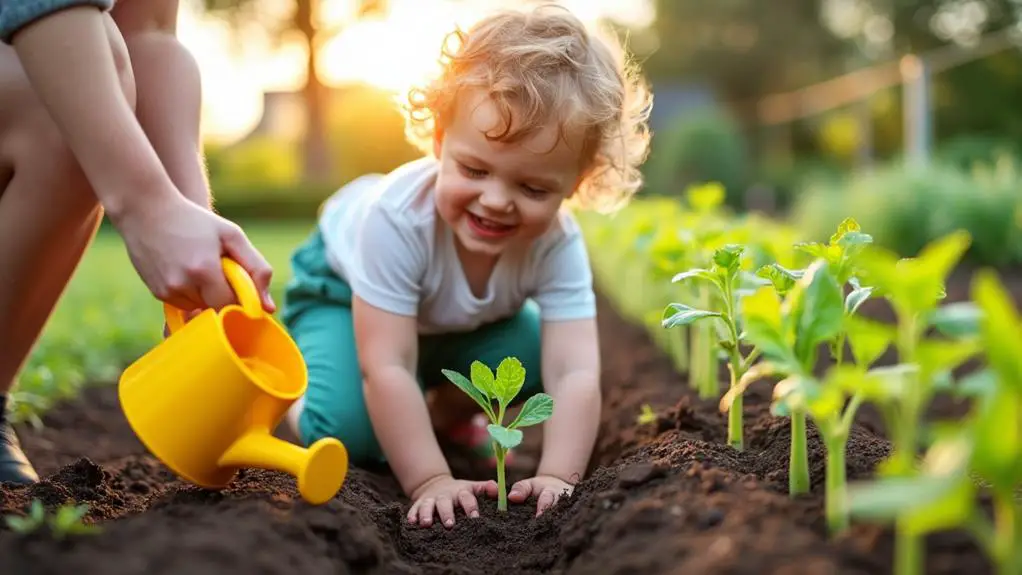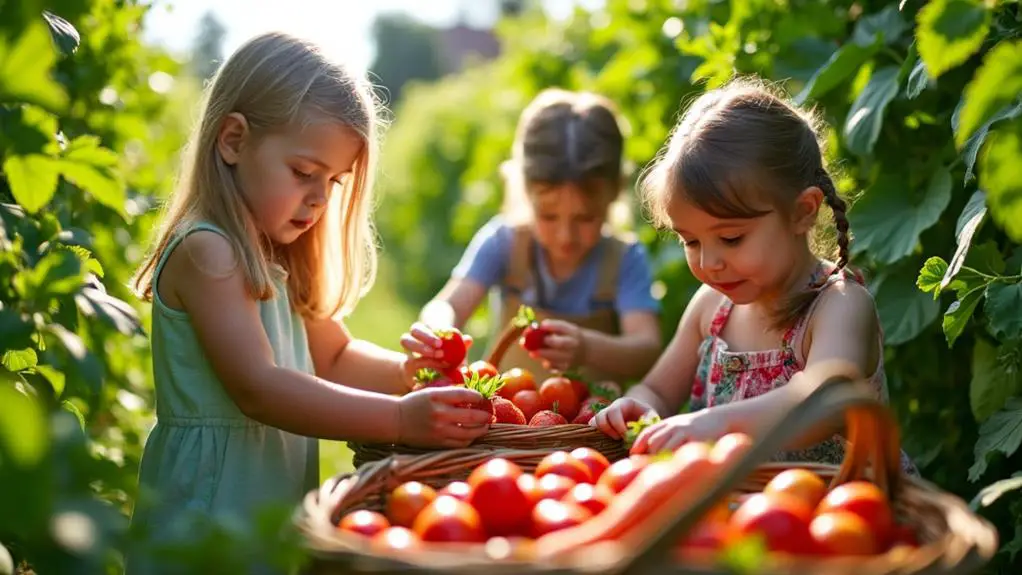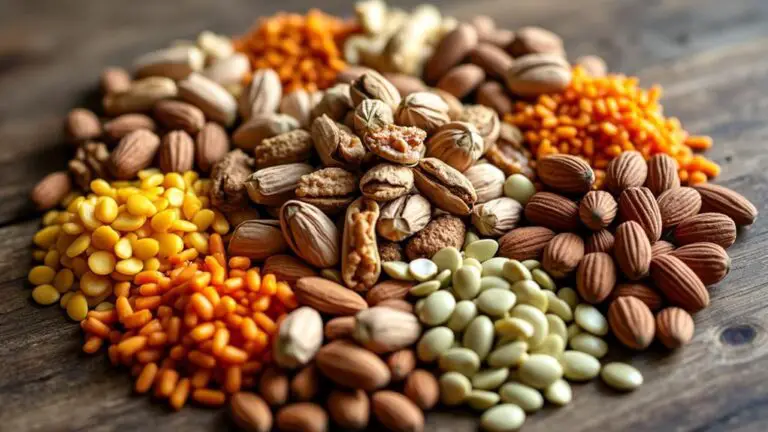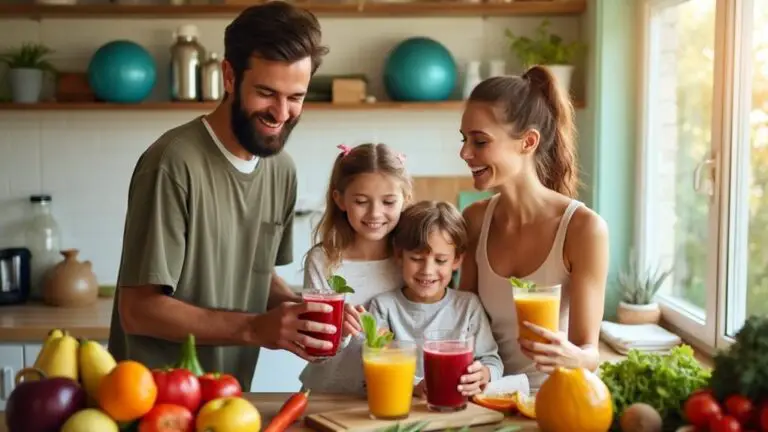Gardening With Kids: Growing Your Own Fruits and Vegetables
Gardening with kids is a fantastic way to grow your own fruits and vegetables while teaching valuable life lessons. Choose fast-growing, easy-to-manage plants like radishes, beans, and cherry tomatoes. Set up a sunny spot with child-sized tools and containers for hands-on learning. Involve your little ones in planting, watering, and monitoring crop growth to foster patience and responsibility. Make it fun with activities like "Mystery Seeds" games and themed gardens. When harvest time comes, let kids pick their own produce and help prepare meals with the fresh ingredients. This engaging experience will cultivate a lifelong appreciation for homegrown food and healthy eating habits. Discover how to create lasting family memories in your backyard garden.
Key Takeaways
- Choose fast-growing, easy-to-grow plants with large seeds for quick results and child-friendly handling.
- Set up a garden space with ample sunlight, suitable containers, and child-sized tools for hands-on learning.
- Involve children in all stages of gardening, from seed selection to harvesting, fostering responsibility and patience.
- Incorporate fun activities like "Mystery Seeds" games and themed gardens to make gardening engaging and educational.
- Encourage children to harvest and prepare meals with homegrown produce, promoting healthy eating habits.
Choosing the Right Plants
When choosing plants for a kid-friendly garden, it's essential to focus on varieties that'll capture children's interest and maintain their enthusiasm.
Opt for fast-growing fruits and vegetables like radishes, which kids can harvest in just 30 days. This quick turnaround provides immediate gratification and excitement for young gardeners.
Select easy-to-grow plants with large seeds, such as pumpkins and beans, which are manageable for small hands. This boosts children's confidence in their gardening abilities.
Don't forget to include visually appealing crops like colorful carrots or strawberries that kids can pick directly from the garden.
For families with limited space, consider container-friendly options like tomatoes and salad greens.
Introduce a variety of textures and flavors by growing diverse crops, including crunchy cucumbers and sweet cherry tomatoes. This approach enhances children's culinary experiences and keeps them engaged in the gardening process.
Setting Up Your Garden Space
The foundation of a successful kid-friendly garden lies in setting up the right space. Choose a spot that receives at least 6-8 hours of sunlight daily to guarantee your fruits and veggies thrive.
When gardening with children, select containers or beds that accommodate their small hands. Make sure pots are at least 30 cm in diameter to allow proper root growth. Use nutrient-rich soil or peat-free compost to give your plants the best start.
Plan your layout carefully, placing sun-loving crops in sunny areas and shade-tolerant varieties in shadier spots. This maximizes your garden's productivity and teaches kids about plant needs.
Don't forget to equip your little gardeners with child-sized tools like hand forks and trowels for soil preparation. Provide watering cans or hoses to help children learn about consistent plant hydration.
Planting and Nurturing Together

Now that you've set up your garden space, it's time to get your hands dirty and start planting. Let your kids help select seeds and participate in the planting process. This hands-on experience teaches them about plant growth stages and nurtures a sense of ownership over their food sources.
Encourage your children to water, weed, and monitor the plants as they grow quickly. These activities foster patience and responsibility while teaching essential gardening skills.
The benefits of gardening with kids extend beyond the garden. As you nurture plants together, you'll create lasting family memories and strengthen bonds through teamwork.
Watch as your children's willingness to try new fruits and vegetables increases when they've grown them themselves. This interactive process not only enhances their appreciation for healthy eating habits but also provides a fun, educational experience for the whole family.
Fun Garden Activities for Kids
Engaging garden activities can transform your outdoor space into a fun-filled learning environment for kids. Organize a "Mystery Seeds" game where children match seeds to plants, enhancing their understanding of how plants grow.
Set up taste-testing sessions after harvest, encouraging appreciation for fresh produce. For older children, create structures like bean teepees or sunflower houses, fostering imaginative play.
In early spring, involve kids in decorating pots for an herb garden, combining creativity with learning about culinary herbs. Plan themed gardens like "Pizza" or "Salsa" patches, making the experience more relatable.
These activities not only educate but also excite children about gardening. By participating in these hands-on tasks, kids develop a deeper connection to nature and gain valuable knowledge about food production and plant life cycles.
Harvesting and Enjoying the Bounty

Harvest time brings excitement and rewards for young gardeners, offering a tangible culmination of their efforts. Encourage your kids to pick fruits and vegetables at their peak ripeness, enhancing flavor and nutritional value.
Let their little hands pluck sweet cherry tomatoes or pull crunchy radishes from the soil, introducing them to a variety of fresh tastes.
Involve children in the entire process, from harvesting to preparing meals. Create homemade salsa or fresh salads together, reinforcing the joy of cooking with ingredients they've grown themselves. This hands-on experience teaches kids about plant life cycles and fosters a deeper connection to their food.
Document the harvest through drawings or photos, creating lasting memories and inspiring future gardening goals. By engaging in these activities, you'll help your children understand which plants grow well and develop a lifelong appreciation for homegrown produce.
Conclusion
You've commenced on a wonderful journey with your kids, planting seeds of knowledge that'll grow like sturdy oak trees. As you nurture your garden together, you're cultivating more than just fruits and vegetables – you're growing memories, life skills, and a love for nature. Keep tending to your little patch of green, and watch as your children blossom alongside the plants. The rewards you'll reap go far beyond the delicious harvests you'll enjoy.







